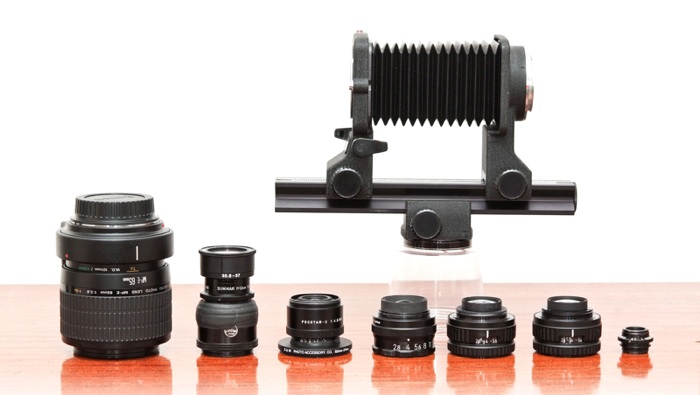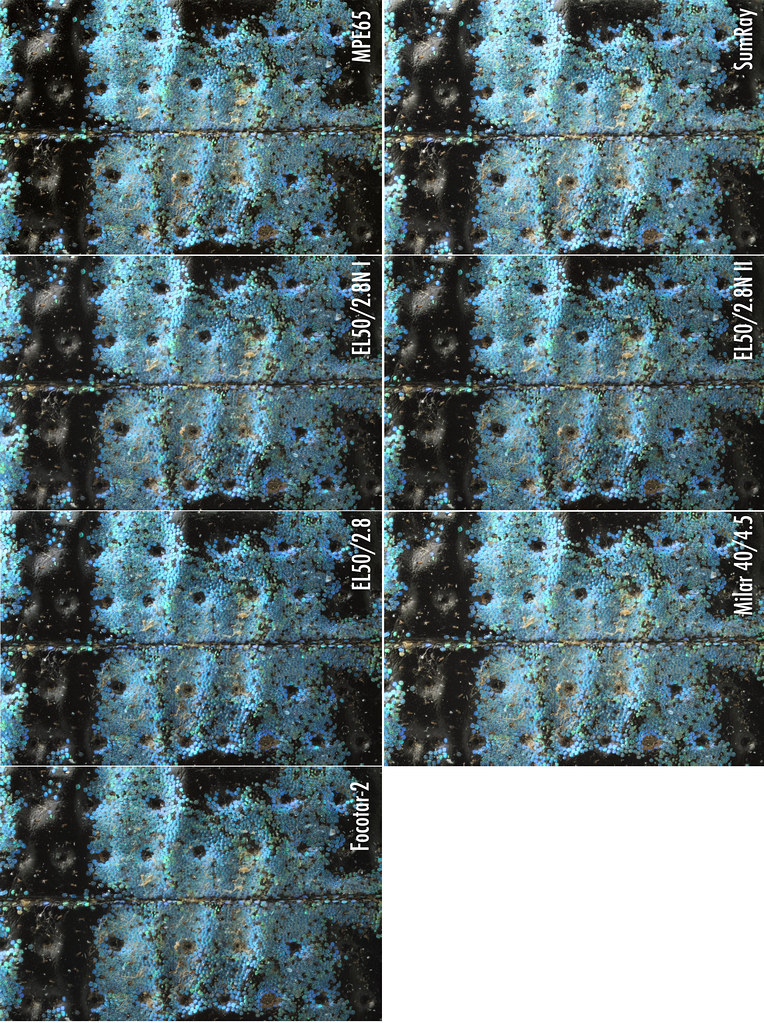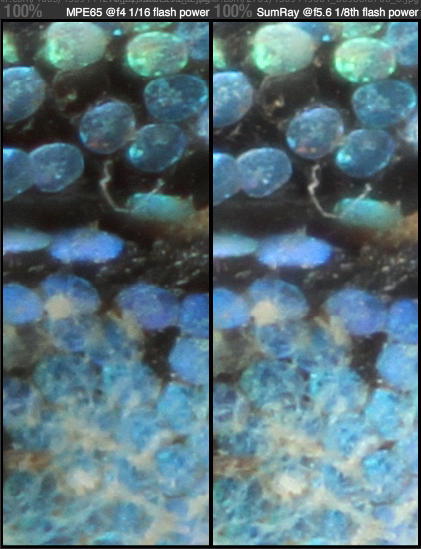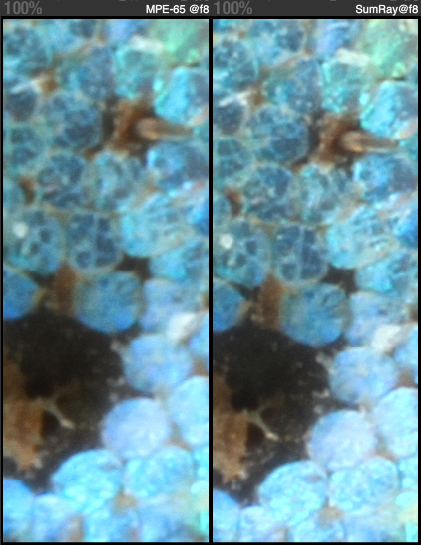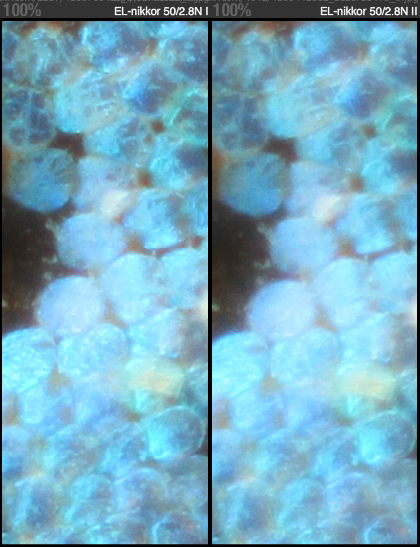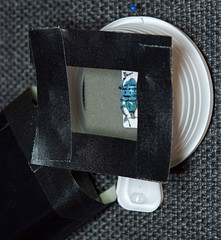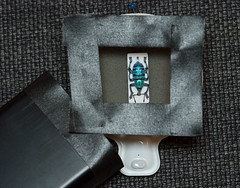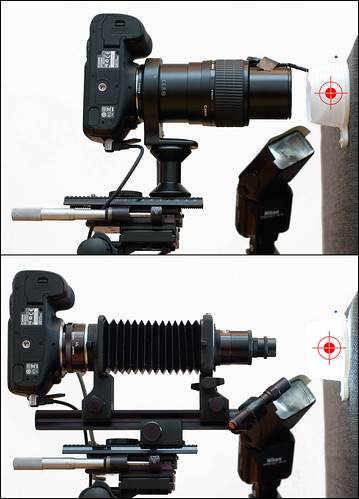MPE65 and six other lenses @ 4.8X
|
|
|
| I’ve made a comparison between the following lenses at 4.8X
Canon MP-E 65mm f/2.8 1-5x (I’m just calling this MPE65 from now on) Initial notes: Camera body used: Canon 7D All but the MPE65 were used on a Nikon PB-6 bellows. Each test image is stacked from 9 exposures using Zerene Stacker. I have included three EL-nikkors for two reasons: This composite is showing all lenses at f5.6. If you click it you’ll get a larger version where each is scaled down to 2000x1333px. Even at that size you can’t make out any differences in terms of resolution but it gives you some idea of how they compare when it comes to white balance and contrast. 18MP FULL RES SAMPLES MPE65 SumRay 50/1.9 Leitz Focotar-2 50/4.5 EL-nikkor 50/2.8N (sample 1) EL-nikkor 50/2.8N (sample 2) EL-nikkor 50/2.8 (old version) Leitz Milar 40/4.5 Lighting was provided by a single Nikon SB-24 flash unit (see below). It was set to 1/16th, 1/8th and 1/4th of full power respectively for each of the three aperture settings. The Milar and the Focotar are both f4.5 at their widest so for these I’ve used this setting instead of f4. Lighting was the same though so theoretically their “widest” image should look half a step or so darker. When conducting the test I made the mistake of thinking of the “SumRay” as a f2.0 lens while f1.9 is closer to the truth. Consequently the SumRay yielded slightly overexposed results since the effective aperture was a little bit larger (of course also meaning a little less diffraction). App for Comparisons Example: MPE-65 vs SumRay @f5.6 MPE-65 @f5.6 vs EL-nikkor @f5.6 Zoom in and out with the “+” and “-” buttons (keyboard or on-screen) and pan using the mouse or arrow keys. Click “Change images” and copy and paste from the URL:s above to compare two images of your choice. (Flash can only juggle 3000×3000 pixels so if the files are larger than that (as in this case) only the top, left 3000x3000pixels of the images are visible) This app is still to be considered a beta-version! OBSERVATIONS Before we begin the pixel-peeping let me just say this: as someone most familiar with the Nikon system and not having used the Canon system for real since the analogue nineties I’m very pleasantly surprised. If Nikon keels over tomorrow I can now rest assured that there is at least one viable alternative out there. The MPE65 oozes quality and is a pleasure to use; it’s perfectly solid even at maximum extension. The 7D + MPE65 is a kit that should satisfy most macro junkies out there, myself included. MPE-65 image quality at 4.8X So, does the MPE65 sweep the floor with the competition? The MPE65 is great when it comes to producing clean, contrasty results with consistent edge to edge performance at wide apertures (f4). At f4 its blacks are blacker than all the other lenses in this test. The micro contrast is also very high and when you put these qualities together the results are very appealing – at least at first glance. You could say that the images appear to have an extra level of clarity, straight out of the camera. In terms of resolving power it’s not better than the competition in this test. And while CA are generally under control the Leitz Milar and Leitz Focotar-2 and to some extent the “SumRay”; are slightly better while the EL-nikkors are slightly worse. CA is only an issue at f4 – at smaller apertures it is insignificant even in the EL-nikkors. The resolution champion in this test is the SumRay. MPE-65 @f5.6 vs. SumRay @f5.6 At f5.6 the SumRay clearly outresolves the MPE-65 (see above). Granted, the SumRay is & “cheating” a little since its effective aperture is slightly wider than f5.6 (perhaps f5.4?) and thereby it is slightly less affected by diffraction. The difference isn’t big but not insignificant either since you can make out that the SumRay image is a little brighter. Remember that the flash output is exactly the same in both cases so any difference in effective aperture would correspond to an equivalent amount of brightness difference. Looking at these images it is clear that it is far from a full stop difference but lets compare the MPE65 @ f4 with the SumRay still at the “less than f5.6” setting anyway: MPE-65@f4 vs. SumRay @f5.6 Here, the MPE65 @f4 to the left gets half the amount of flash output (1/16th) compared to the SumRay (1/8th). So in this case the MPE65 certainly has the benefit of larger effective aperture. Still, resolution-wise the SumRay is on par with the MPE65 or even a little bit better. Stopping down to f8 takes us further into diffraction territory but the resolution difference is still obvious: MPE-65@f8 vs. SumRay @f8 In fact, at f8 the Canon has the lowest resolution of all the lenses in this test. Also, at this setting the contrast/clarity advantage this lens showed at the wider settings is completely gone. The MPE65 is a good performer but at this magnification we seem to be pushing its upper limit. While it has the edge in contrast/clarity at the wider settings this is really only an issue if you want to do a minimum of adjustments in post – a simple levels adjustment would cancel most difference between the MPE65 image and the results produced by the other lenses in this test. Also, at f4 and 4.8X, stacking is almost a must and if you are the kind of photographer who accepts focus stacking as part of your workflow you are unlikely to shy away from a simple levels adjustment. Subjective performance EL-nikkor @f4 vs. Focotar-2 @f4.5 The EL-nikkor @f4 resolves finer detail than the Focotar-2 consistently throughout the frame. On the other hand, the Focotar-2 is almost completely free from CA whereas the EL-nikkor shows relatively much of it. In a case like this I would pick the Focotar-2 without hesitating, but I can see how others might be less sensitive to CA and always opt for maximum resolution! Another thing that is often and easily overlooked is sample variation. Two samples of EL-nikkor 50/2.8 N @f4 This test confirms my suspicion that these two virtually identical lenses behave quite differently at f4; One is clearly better than the other. At this setting the difference between these two samples of six element design lenses is larger than the difference between the “good” sample and the three element Milar 40/4.5. Is one of the EL-nikkors to be regarded as a lemon? I’m not so sure! At f5.6) and f8 they are indistinguishable – well, if anything the “bad” one shows a little less (!) CA. Some additional thougths and rants I really don’t mean to bash the MPE65 but I’d like to point out some weaknesses just to counterbalance the praise this lens often receives (and for the most part deserves). The following crop (shot at 1:1 and f16) shows another less than perfect aspect of this lens:
The straight, six bladed iris of the MPE65 can render out of focus highlights in a rather unattractive way. More often than not this will not be a problem but there are occasions where this kind of OOF highlights can become obtrusive in my opinion. This is especially true if there is a lot of dew drops or very moist, textured substrate in the frame. Apart from being unattractive this sort of highlights can become a problem when stacking. The Summar 12cm has no less than 15 rounded diaphragm blades and even when stopped down all the way its opening forms a perfect circle:
This probably wouldn’t be possible with an auto-aperture lens though since the friction between the blades would prevent it from stopping down fast enough. In fact, in cold weather it takes quite a lot of torque to change aperture on the Summar. If I was a Canon user I would most likely buy the MPE65. It’s a unique, flexible and well built lens and it offers a lot of convenience especially if you don’t want to lug around a bulky and sensitive bellows unit. If you are a Nikon macro shooter I don’t think the MPE65 should be reason enough for you to change systems. The old Micro-nikkor 105/f4 combined with Raynox diopters offer a great alternative. However, there are other things that Canon does better than Nikon in my opinion: I still think Canon’s Live view and Mirror lock up is superior to Nikon’s. And I much prefer to be able to set the nominal aperture rather than the effective aperture that Nikon forces you to use (with modern optics). If I was to pick a winner in this test it would have to be the SumRay. It outresolves the rest and shows only little CA. Not only is it a stellar performer but it is also very flexible: Changing the Raynox +12 diopter for a Raynox +6 diopter gives you an excellent 70/f2.6 (very useful for bugs). With a Raynox +25 diopter you get a high magnification 30/f1.2 (which becomes excellent, stopped down a bit). On its own the Summar 12cm is wonderful for lower magnification macros (below and around 1:1) and portraits. If you can tolerate a fair bit of edge softness you can even use it for landscape work. I have a feeling my beloved Sigma 150/2.8 will have to work to defend its place in my bag the upcoming season ;-) The Raynox lenses continue to amaze me with their optical brilliance. I rate them as among the finest pieces of glass I’ve ever used. Quite astonishing considering their price tags! They perform a little bit differently depending on which lens you put them on though so you can’t smack them onto anything and expect wonders. For instance I tried the +12 diopter on the Canon 100/2.8 USM macro lens: The results were not bad but nowhere near as good as from the MPE65. These are my opinions and conclusions. Go ahead and pixel peep the samples and please feel free to disagree with me! And if you do, please tell me – I’d like to hear your opinion! Test Setup However, one very significant difference was the lighting setup. This time I’ve taken measures in order to shade the front elements of the lenses and hereby flare was drastically reduced! The shading was done by adding a small “snout” around the flash head and (more importantly) a “mask” around the diffuser-cup. Simple but extremely effective! Just compare the contrast from EL-nikkor between this test and the last one I did.
I mounted the MPE65 on the same micrometer controlled linear stage as I used with the bellows: Here you see MPE65 compared to Zeiss Luminar 63/4.5 (not included in this test) at the same magnification and plane of focus. As you can see there is a significant difference in extension. Anybody here knows the actual focal length of the MPE65 at 5X? This also illustrates another point: a small lens leaves much more room for lighting the subject. Another good thing with small lenses is that they are less likely to scare skittish subjects away. Considering how small the front element of the MPE65 is, I don’t see why Canon couldn’t have made the barrel a little slimmer. It doesn’t have to look like an endoscope but shaving off a little bit of girth at the front end of the lens would have many benefits: |



